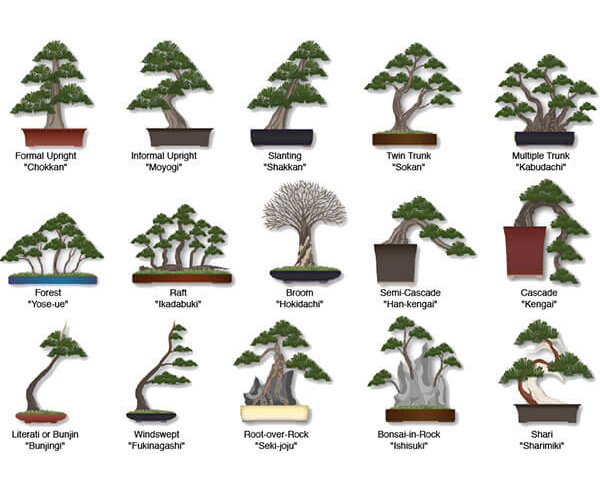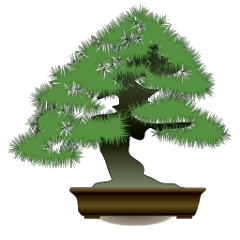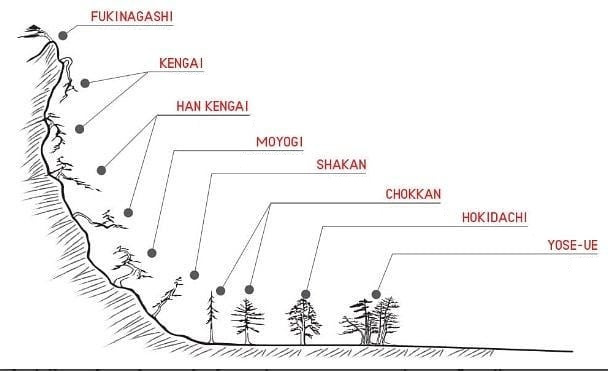To make a good bonsai you need to have a special relationship with plants. You have to see them as they are in nature to be able to give them a shape that is natural and to ensure that the hand of man is not seen, but intuited.Antonio Ricchiari

Formal Upright (Chokkan)
In this style the trees have a completely straight and vertical trunk. Once much more popular, it is now less used as most vertical bonsai are informal upright. Ideally, the trunk should resemble a cone from the base to the apex. This shape resembles trees that grow unimpeded in open spaces, without competition from other trees. The branches leave the trunk alternately from left to right to the rear and without branches facing the front up to the upper third of the structure. All branches will be mostly horizontal or slightly drooping as if weighted down by snow in winter. It can be a difficult shape to make and it is recommended to work with naturally straight shaped trees. The shape of a formal erect is triangular even if not strictly symmetrical, deciduous species are not suitable for this style while conifers such as yew, cypress and cryptomeria are good candidates.
Informal Upright (Moyogi)
It is the most common form, if you look at trees in nature. It can be used for most tree species. The trunk can twist, rotate and change direction with a number of curves along its length even if the growth is substantially upwards. The branches tend to emerge from the outside of the curves of the trunk.
Broom (Hokidachi)
The inverted broom shape has a main trunk that divides at a certain point into three or more branches of approximately equal thickness that grow diagonally upwards from the central trunk. The shape of the tree resembles an upside-down Japanese broom, hence the name. The main trunk of the broom conventionally tends to be 1/3 of the overall height of the bonsai. There are no horizontal branches; all the branching is placed diagonally in the form of a fan.
Slanting (Shakan)
In this form the trunk tilts as if it were growing towards the light or as if it were exposed to a strong wind. The trunk can be straight or curved with the branches on the sheltered side lower than their counterparts on the other side of the trunk. An important feature of this shape is that the nebari (roots) must be exposed to anchor the tree, as if to prevent it from ‘falling’. The roots on the side towards which the tree leans must be short and compressed, while the roots on the opposite side should be strong and dominant, just to anchor the tree to the ground.
Windswept (Fukinagashi)
This style is one of the most difficult forms to make as a bonsai although it is often very attractive to beginners. The windswept style is also one of the most misunderstood forms, with a tendency to direct all branches to only one side of the trunk, at the expense of the final shape.
Twin trunck (Sokan)
In this form, two vertical trunks emerge from the same roots. Both trunks (trees) must have similar shapes and characteristics having grown together in the same environment. However, it is important that one trunk is considerably taller, thicker and stronger than the second, as if it had received more sunlight and more nourishment than the other trunk.
Multiple Trunk (Sankan)
It is a variant of the Sokan style from which it differs in that three trunks branch off from the same root instead of two. Also in this case the stems to stand out aesthetically must have different sizes: the most developed will be called “father”, the smallest “son” and the intermediate “mother”.
Clump (Kabudachi)
It is a variation of the Sokan style. By exploiting the radical jets that branch off from the root, an unspecified number of stems is grown. In any case, the number of drums is higher than three and always in an odd number. In nature it is typical of oaks, beeches, ash trees, some species of maples.
Forest (Yose-ue)
In this form a group of trees with their own roots are planted together in such a way as to create a miniature forest. An odd number of plants must be used, unless that number is greater than 13 or 15 trees. Trees of the same species with fairly straight trunks of various sizes and heights are used. Overall, an overall irregular triangular shape should be created.
Raft (Ikada-buki)
This style replicates those trees whose branches point upwards and sprout from a single fallen tree trunk. Essentially very similar to a forest, except that each tree is supported by the same connected root system.
Cascade (Kengai)
This style is unusual as the apex of the trunk is not the highest point of the structure. It represents a tree that grows from the side of a cliff and descends downwards, although it may have a small portion that grows upwards. Since the natural tendency of trees is to grow upwards, it can be very difficult to stimulate vigor in a bonsai that is forced to grow downwards. Waterfalls are often tempted by beginners for their striking shape, but it’s rare to see good quality full waterfall shapes. In this style, the apex of the plant is lower than the lower edge of the pot.
Semi-Cascade (Han-Kengai)
In the semi-cascade form, unlike the cascade style, the apex of the plant falls between the base and the lower edge of the pot. The semi-cascade shape also includes trees with horizontal trunks that end at approximately the same height as the edge of the vase. The roots must appear strong on the opposite side of the trunk direction.
In rock (Ishitsuki)
In this form the bonsai is planted directly into a hollow or piece of porous stone placed on a rock, with its roots running down into a compost-filled container. These forms replicate trees that naturally grow in mountainous and rocky regions and must extend their root systems into barren rock to find enough sustenance to survive.
Literati (Bunjin)
Literate bonsai are named after an elite class of Chinese scholars. In their paintings, abstract figures and calligraphic forms depicting trees grown in mountainous landscapes were depicted. These trees owe their shapes to the extreme climatic conditions, in fact they have long and thin trunks. Bonsai of this type have few branches that start very high from the trunk, just enough to allow the foliage to survive.
Exposed roots (Neagari)
Some large exposed roots follow the course of the trunk for long stretches, prolonging it, while others, generally thinner, detach from it: the plant appears as if suspended and the whole suggests sensations of airy lightness. Currently little used, this style has experienced periods of great prosperity in the past.
Driftwood (Sharimiki)
In this style, appropriately treated dry wood prevails. In extreme cases, one or more lateral branches, joined by a thin line of bark at the roots, reconstruct the plant and give the impression of a tree that has survived strong natural disasters.



